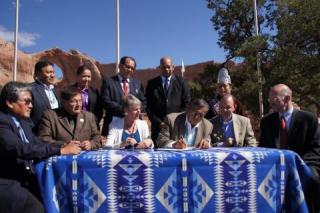by Stephanie Mack, Hillerman Fellow
Originally published on Celebrating New Mexico Statehood, 6/10/2016
It was a historic moment in history on September 26, 2014: the Navajo Tribal Council approved a $554 million dollar settlement from the U.S. government, with a thirteen “for” and three “against” vote. In 2006, the Navajo nation filed suit against the federal government for $900 million dollars because of its mismanagement of tribal resources, and last month’s settlement is the result of eight years of litigation. The president of the Council, Ben Shelly, called this settlement for the tribe “a victory for tribal sovereignty.” However, while the settlement was approved by the Navajo Tribal Council, it was not unanimously approved. Three members voted against accepting the settlement, and did so not because they did not want the settlement but because they disagreed with the speed with which the settlement was approved. The bill was brought before the Council and voted upon without any public involvement or comment. The Council majority justified the speed of this approval, because it did not want to jeopardize settlement and wanted to publicly demonstrate union within the Council. However, some Council members felt that the settlement was never in jeopardy, and by not allowing people to comment on the legislation, “…the approval of the bill undermines the transparency that the Council often advocates amongst the Navajo people.” Regardless of the “against” votes, the $554 million will be deposited in the Navajo Nation’s bank account by the end of the year. This settlement is one of more than one hundred cases brought by tribes against the U.S. government that the Obama administration has settled since 2010. In the last four years, more than two billion dollars has been awarded to tribal nations in settlements by the federal government. However, the federal government’s settlement with the Navajo Nation is the largest sum ever awarded to a tribe. How will the settlement be spent? During the official announcement ceremony, both President Shelly and Navajo Nation Council Speaker Pro Tem LoRenzo Bates had ideas about how to spend the funds. Shelly stated that he would like the funds to pay for infrastructure projects, while Bates wanted the funds to go to energy, roads, houses, and scholarships. Either way the Navajo Nation will be $554 million dollars richer come January.
Source: Navajo Times
Photograph: "DSC05524" by Jared King is licensed under CC BY-ND.

